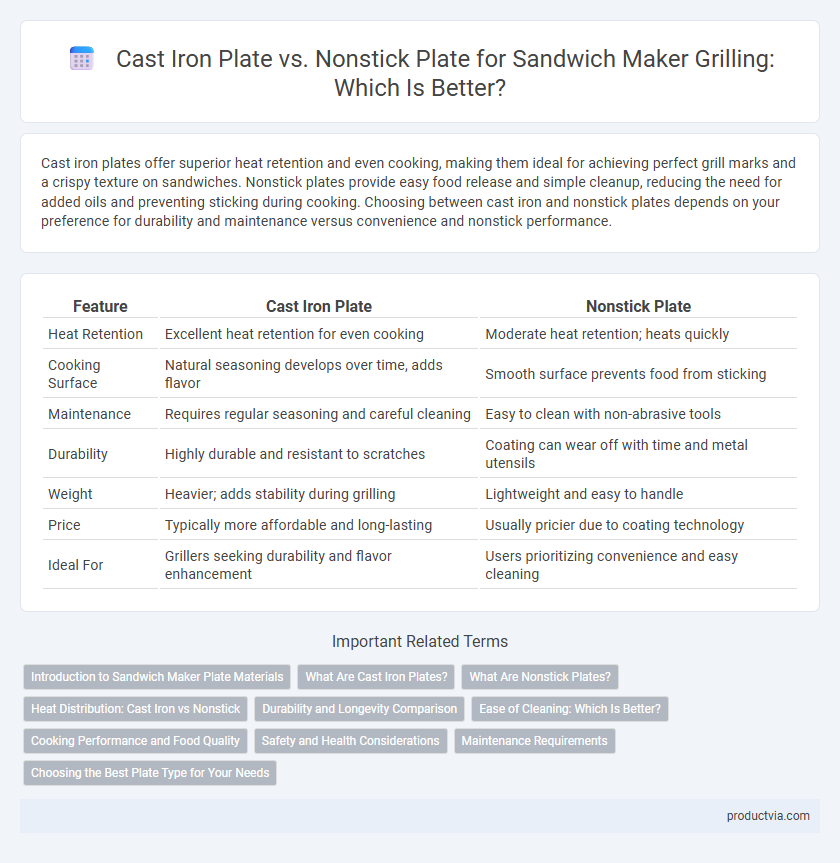Cast iron plates offer superior heat retention and even cooking, making them ideal for achieving perfect grill marks and a crispy texture on sandwiches. Nonstick plates provide easy food release and simple cleanup, reducing the need for added oils and preventing sticking during cooking. Choosing between cast iron and nonstick plates depends on your preference for durability and maintenance versus convenience and nonstick performance.
Table of Comparison
| Feature | Cast Iron Plate | Nonstick Plate |
|---|---|---|
| Heat Retention | Excellent heat retention for even cooking | Moderate heat retention; heats quickly |
| Cooking Surface | Natural seasoning develops over time, adds flavor | Smooth surface prevents food from sticking |
| Maintenance | Requires regular seasoning and careful cleaning | Easy to clean with non-abrasive tools |
| Durability | Highly durable and resistant to scratches | Coating can wear off with time and metal utensils |
| Weight | Heavier; adds stability during grilling | Lightweight and easy to handle |
| Price | Typically more affordable and long-lasting | Usually pricier due to coating technology |
| Ideal For | Grillers seeking durability and flavor enhancement | Users prioritizing convenience and easy cleaning |
Introduction to Sandwich Maker Plate Materials
Cast iron plates in sandwich makers offer excellent heat retention and even cooking, making them ideal for achieving a crispy, flavorful crust. Nonstick plates provide effortless food release and easier cleaning, which is particularly beneficial for delicate sandwiches with cheese or sauces. Selecting the right plate material depends on cooking preferences, maintenance willingness, and the desired texture of grilled sandwiches.
What Are Cast Iron Plates?
Cast iron plates are made from heavy-duty iron alloys known for excellent heat retention and even heat distribution, making them ideal for consistent grilling surfaces in sandwich makers. Their durability allows for high-temperature cooking that enhances browning and crispiness, while their ability to improve seasoning over time creates a naturally non-stick surface. Cast iron plates require regular maintenance with oiling to prevent rust and maintain optimal performance compared to nonstick coated plates that offer easy cleanup but less longevity.
What Are Nonstick Plates?
Nonstick plates in sandwich makers feature a coating such as PTFE (Teflon) that prevents food from sticking during grilling, ensuring easy release and simple cleaning. These plates provide even heat distribution, reducing the risk of burning and promoting consistent cooking results. Unlike cast iron plates, nonstick surfaces require less maintenance and do not need seasoning, making them ideal for everyday use.
Heat Distribution: Cast Iron vs Nonstick
Cast iron plates provide superior heat distribution and retention, ensuring evenly cooked sandwiches with consistent browning. Nonstick plates heat up quickly but often have uneven temperature zones, which can cause inconsistent grilling results. The dense structure of cast iron offers a more stable cooking surface ideal for prolonged grilling compared to the thinner, less durable nonstick material.
Durability and Longevity Comparison
Cast iron plates offer exceptional durability and longevity due to their robust construction and ability to withstand high temperatures without warping or degrading, often lasting decades with proper maintenance. Nonstick plates provide convenient cleaning and reduced food sticking but generally have a shorter lifespan, as the coating can deteriorate and peel after prolonged use or exposure to metal utensils. Choosing cast iron ensures a grilling surface that improves with seasoning and resists wear over time, while nonstick plates may require more frequent replacement to maintain optimal performance.
Ease of Cleaning: Which Is Better?
Cast iron plates offer exceptional heat retention but require seasoning and careful cleaning to prevent rust, making maintenance more labor-intensive. Nonstick plates provide effortless cleaning as food residue rarely sticks, allowing quick wipe-downs with minimal scrubbing. For ease of cleaning, nonstick plates are generally better suited for busy users seeking convenience and low maintenance.
Cooking Performance and Food Quality
Cast iron plates offer superior heat retention and even distribution, resulting in perfectly grilled sandwiches with a crispy crust and enhanced flavor due to natural seasoning buildup. Nonstick plates provide quick release of food and easier cleaning but may lack the high-temperature searing capabilities that develop deep, rich textures in grilled sandwiches. Choosing cast iron enhances cooking performance and food quality by delivering consistent browning and a robust grilling experience.
Safety and Health Considerations
Cast iron plates offer a naturally non-toxic grilling surface that withstands high temperatures without releasing harmful chemicals, making them safer for frequent use. Nonstick plates often contain chemical coatings such as PTFE, which can degrade at high heat and potentially release toxic fumes, posing health risks during prolonged grilling. Regular maintenance of cast iron plates prevents rust and ensures a safe cooking surface, while nonstick plates require careful temperature control to avoid chemical exposure.
Maintenance Requirements
Cast iron plates require regular seasoning to maintain their nonstick properties and prevent rust, involving oiling after each use. Nonstick plates demand gentle cleaning methods, avoiding abrasive tools to preserve the coating's integrity and extend lifespan. Both types benefit from thorough drying, but cast iron requires more consistent upkeep to ensure durability and optimal grilling performance.
Choosing the Best Plate Type for Your Needs
Cast iron plates offer superior heat retention and durability, making them ideal for achieving evenly grilled sandwiches with a crispy texture. Nonstick plates provide easy food release and effortless cleanup, perfect for casual use and reducing oil consumption. Selecting the best grilling surface depends on balancing maintenance preferences with desired cooking performance and longevity.
Cast iron plate vs Nonstick plate for grilling surface Infographic

 productvia.com
productvia.com